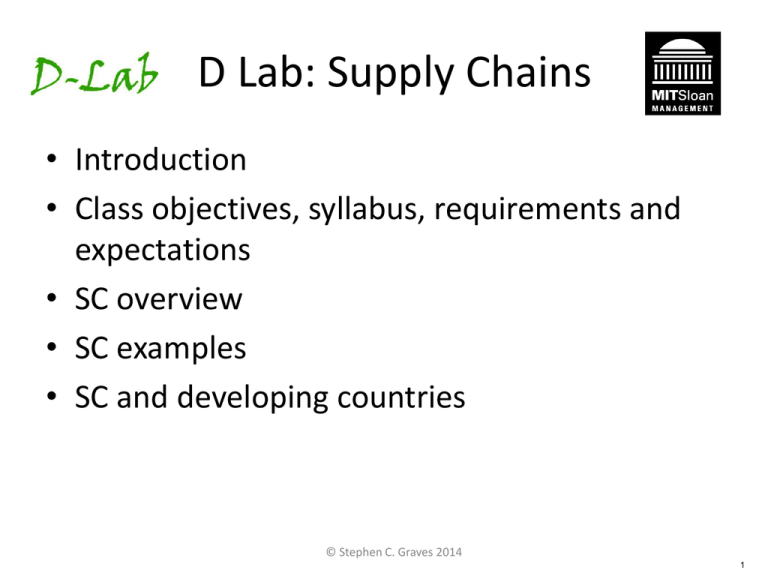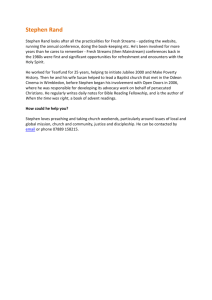
D Lab: Supply Chains
• Introduction
• Class objectives, syllabus, requirements and
expectations
• SC overview
• SC examples
• SC and developing countries
© Stephen C. Graves 2014
1
Class Objectives
• Introduce concepts of supply chain design and operations
with a focus on supply chains for products destined to
improve quality of life in developing countries
• Objectives are to develop an understanding of the challenges
in the design and planning of supply chains, to learn
applicable modeling skills and problem-solving tools and to
have the opportunity to apply these skills in a real-world
project.
• What are your objectives?
© Stephen C. Graves 2014
2
Requirements and Expectations
• Come to class prepared
• Individual assignments: problem sets & a series of
short write-ups
• Group assignment: term project
• Group size: 2 - 4 students
• Participate in class; provide feedback on how to
improve
© Stephen C. Graves 2014
3
Supply Chain Management
• Supply chain is two or more parties linked by a
flow of resources – typically material,
information and money
• SCM entails the management of activities
surrounding the flow of raw materials to the
finished product or service enjoyed by the end
customers, and back, in the case of recycling
and returns.
• SCM: Buy, Make, Move, Store, Sell
© Stephen C. Graves 2014
4
SCM spans the functions of
operations, marketing and
finance
Make the Stuff
SUPPLY CHAIN
MANAGEMENT
Sell the Stuff
Finance the Stuff
© Stephen C. Graves 2014
5
Supply Chain Management
• SCM is a set of approaches utilized to
efficiently integrate suppliers, manufacturers,
warehouses, and stores, so that merchandize
is produced and distributed at the right
quantities, to the right locations, and at the
right time, in order to minimize system-wide
costs while satisfying service level
requirements
© Stephen C. Graves 2014
6
Projects 2012: D lab supply chains
• Natural Dye Crayons
– Sourcing of raw material
– Capacity assessment
– Distribution channels
• Ag Waste Charcoal
– Cost modeling and process analysis
– Right level of centralization vs. decentralization
© Stephen C. Graves 2014
7
Projects 2012: D lab supply chains
• EssMart
– Design of distribution system
– Assortment planning
– Inventory planning
• Freedom Chair
– Cost modeling and process analysis
– Amount of local content
• Moringa Oil
– Assessment of demand and possible market channels
© Stephen C. Graves 2014
8
Projects 2013/sp: D lab supply chains
• Pure Home Water
– Bottleneck analysis of supply chain
– Examination of micro-finance options for
distribution and marketing
• SolarClave
– Evaluation of sourcing and manufacturing options
– Identification of opportunities for design
improvement
© Stephen C. Graves 2014
9
Projects 2013/sp: D lab supply chains
• Barefoot Power
– Determine best way to handle warrantee claims
– Where and how to do repairs?
– How much inventory, who holds it and where?
© Stephen C. Graves 2014
10
Projects 2013/Fa: D lab supply chains
• TEWDI Charcoal
– Built a spreadsheet model to:
• Determine production capacity, given space constraints
• Model return on investments from improving
production technology
• Optimize labor allocations and assignments
© Stephen C. Graves 2014
11
Projects 2013/Fa: D lab supply chains
• Wecycler
– How it improve SC performance as firm scales
– Mapping of SC
– Root cause analysis of missed productivity targets
– Proposed treatments to address issues and
improve productivity
© Stephen C. Graves 2014
12
© Wecyclers. All rights reserved. This content is excluded from our Creative Commons
license. For more information, see http://ocw.mit.edu/help/faq-fair-use/.
© Stephen C. Graves 2014
13
Potential Projects
Name
Area
Air Liquide
Frugal oxygen SC for supporting
hospitals
ARTI Charcoal
Project
Charcoal Briquettes: modeling
new production line
Wecyclers
Better route planning; better
customer retention
Ghonsla
SC for insulation panels;
transportation improvement
© Stephen C. Graves 2014
14
Overview of the Course
Manufacturer
Supplier
Distributor
Consumer
© Stephen C. Graves 2014
15
Demand Estimation
© Stephen C. Graves 2014
16
Capacity Planning, Process Analysis,
and Production Flow Control
© Stephen C. Graves 2014
17
Inventory Management
© Stephen C. Graves 2014
18
Supply Chain Contracts
© Stephen C. Graves 2014
19
Lean Production System
© Stephen C. Graves 2014
20
SC Design
How many locations and where?
Who serves whom?
© Stephen C. Graves 2014
21
Reverse Logistics and Recycling
© Stephen C. Graves 2014
22
Common reasons for system slack
•
•
•
•
•
•
Uncertainty in input or output processes, or in demand
Time lags & capacity limits
Scale economies
Predictable variability in supply or demand
Conflicting objectives or incentives
Need for immediate or short service times
© Stephen C. Graves 2014
23
Supply Chain Example
© Stephen C. Graves 2014
24
Facts about Kerosene
• Over US$ 10 Billion is spent each year on kerosene
for lighting homes in poor countries
• Nearly 4 million women suffer from severe burns
from open fires and kerosene lighting each year
• 1.6 million deaths per year in developing countries
are caused by indoor air pollution due to
traditional fuels
© Stephen C. Graves 2014
25
© Barefoot Power Pty Ltd. All rights reserved. This content is excluded from our Creative
Commons license. For more information, see http://ocw.mit.edu/help/faq-fair-use/.
Price: > $100
Price: $20-$30
© Stephen C. Graves 2014
26
BFP’s Supply Chain
All Rights Reserved Copyright, Stephen C.
© Stephen
C. Graves
Graves
2014 2014
2299
27
BFP’s Supply Chain
Non-Profits
Retail
Manufacturer
in China
BFP Distribution Center
Kenya/Uganda
Businessmen
?
Consumers
© Stephen C. Graves 2014
28
BFP’s Supply Chain - Manufacturing
Manufacturer
in China
BFP Distribution Center
Kenya/Uganda
• Slow
• Products transported
by ship
• Large volume of
products
• High transportation
costs
• Little uncertainty
• Plenty of information
and visibility
• Known costs
© Stephen C. Graves 2014
29
BFP’s Supply Chain - Distribution
• Fast
• Products transported
by truck or bike
• Low volume of
products
• Low transport cost
• A lot of uncertainty
• Little information and
visibility
• Unknown # of tiers
• Unknown costs
Non-Profits
Retail
BFP Distribution Center
Kenya/Uganda
© Stephen C. Graves 2014
Businessmen
?
Consumers
30
BFP’s Supply Chain
• How can we couple these two “systems”?
• Slow
• Large volume of
products
• Little uncertainty
• A lot of visibility
Inventory
© Stephen C. Graves 2014
• Fast
• Low volume of
products
• Low transport cost
• A lot of uncertainty
• Little visibility
31
Challenges in Emerging Markets:
What’s different?
© Stephen C. Graves 2014
32
Uncertainty
•
•
•
•
Lack of information
Lack of Visibility
Currency fluctuations
Supply Chain disruptions
© Stephen C. Graves 2014
33
Contrasts: Modern vs. Traditional
Market in Kenya
Market in Kenya
© Stephen C. Graves 2014
34
SCs and developing countries: what’s
different?
•
•
•
•
•
Delivered cost is of primary importance for consumer goods
Lead times longer, more uncertain
More uncertainty in demand, in supply
SC disruptions may be more common
Information and logistical infrastructures are much less
developed
• More tiers across SC; more hand-off’s
• Service aftermarket (ie repair parts and service) may not exist
• Financial credit may be less common
© Stephen C. Graves 2014
35
Assignment for Monday
•
•
•
•
Pick a product that you own, or use, or consume.
Describe its supply chain as you know or imagine it, going as far upstream as
possible to raw materials.
–
–
–
–
Where and how was it made?
Where were its components made?
Where were the raw materials sourced from?
How long did this take? How many steps and movements?
What type of slack might there be in this supply chain, and where, and for
what reasons?
What do you imagine are the key challenges in the planning and operation of
this supply chain?
•
Please submit a 1 page write up addressing these points.
•
Slack --- is meant to convey an allowance in the system to accommodate
uncertainty in the supply chain, or inflexibilities, or to take advantage of
economies of scale or scope
© Stephen C. Graves 2014
36
Start reading “The Goal”
The Goal: A process of
ongoing improvement
by Eliyahu Goldratt
© Stephen C. Graves 2014
37
MIT OpenCourseWare
http://ocw.mit.edu
15.772J / EC.733J D-Lab: Supply Chains
Fall 2014
For information about citing these materials or our Terms of Use, visit: http://ocw.mit.edu/terms.




